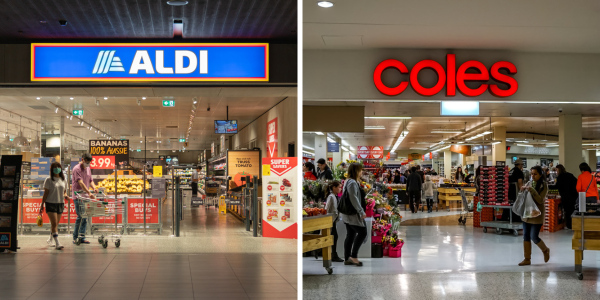ALDI vs. Coles: Customer shares shocking price difference between two major supermarkets
By
VanessaC
- Replies 14
When it comes to trimming the weekly grocery bill, Australian shoppers are constantly looking for ways to stretch their dollars further.
In a striking example recently shared by an Aussie consumer, the remarkable savings one can achieve by switching supermarkets became abundantly clear.
An ALDI shopper shared her savvy shopping strategy online, revealing she managed to cut over $50 from her $348 grocery shop at Coles by opting instead to purchase from ALDI.
The shopper’s post has sparked renewed debate on the cost differences between the major supermarkets.
Her social media revelation laid out the cold hard numbers: 'I’ve been seeing a lot of posts that the price between ALDI and Coles is not much different—if I had bought all this only at Coles, it would have cost me $348.95.'
'I took my Coles list to ALDI and purchased everything that was cheaper there and all my fruit and [vegetables] at the grocer. In total, this shop was $297.65.'
This comparative shopping approach showcased the potential impact of a mixed-bag strategy where consumers shop at different outlets—mainstream supermarkets and discount grocers like ALDI and IGA—to maximise savings without compromising on their shopping list.
The debate amongst shoppers was lively and multifaceted, with preferences influenced by more than just price.
While some consumers are committed to Coles or Woolworths, citing rewards points and loyalty programs as reasons for sticking with these staples, others highlighted the substantial savings available at ALDI.
'I did this once,' one wrote.
'Bought all my stuff at ALDI, then went home and put all the stuff in a Woolies online order. Even picking home brand stuff and stuff on special at Woolies, the total was $250, and ALDI was about $200. Such a big difference.'
'I've definitely noticed fruit and [vegetables] at smaller local stores and local IGA discounts [are so] much cheaper than Coles and Woolies, and sometimes ALDI,' another replied.
'ALDI is cheaper for sure with 90 per cent of products, but ALDI also doesn't have everything Woolies and Coles have.'
Another commented: 'Yep, ALDI is still definitely cheaper for me. I know many people like the rewards from Woolies and Coles, and I do have Everyday Extras myself, but even the points and savings from this program don't make up for the amount I save each week at ALDI.'
'I do shop specials at Coles and Woolies, but shopping there just because of the points seems silly to me when I would be spending, on average, about 15 per cent more to do so.'
Some shoppers claimed it was cheaper to do their groceries at Coles or Woolies.
'Still cheaper for me to do a big shop at Coles,' one commented.
'Between the specials and points from rewards programs adding up so quickly, I definitely save overall at Coles. (I) still go to ALDI for a few things I like though.'
'I like ALDI for bits and pieces, but I [found] that [for] brand stuff, I need to go to Woolworths.'
A comparison by Finder late last year, purchasing 50 specific items, saw ALDI emerge as the most wallet-friendly option at $200, with Coles at $214 and Woolworths at $207.
Chris Ford from Compare The Market pointed out, 'Our latest research found that the average Aussie spends $193 on groceries per week, which is around $836.33 a month or $10,036 a year.'
'One way that we know many households are saving at the checkout is by shopping where the sales are.'
'In addition to the weekly specials that run at the major supermarkets, we know there are great savings to be found at smaller grocers, challengers, department stores, discount stores and more. Similarly, people are finding savings by switching from brand-name items to generic alternatives.'
 Have you ever compared prices between supermarkets before? Share your findings with us in the comments below!
Have you ever compared prices between supermarkets before? Share your findings with us in the comments below!
In a striking example recently shared by an Aussie consumer, the remarkable savings one can achieve by switching supermarkets became abundantly clear.
An ALDI shopper shared her savvy shopping strategy online, revealing she managed to cut over $50 from her $348 grocery shop at Coles by opting instead to purchase from ALDI.
The shopper’s post has sparked renewed debate on the cost differences between the major supermarkets.
Her social media revelation laid out the cold hard numbers: 'I’ve been seeing a lot of posts that the price between ALDI and Coles is not much different—if I had bought all this only at Coles, it would have cost me $348.95.'
'I took my Coles list to ALDI and purchased everything that was cheaper there and all my fruit and [vegetables] at the grocer. In total, this shop was $297.65.'
This comparative shopping approach showcased the potential impact of a mixed-bag strategy where consumers shop at different outlets—mainstream supermarkets and discount grocers like ALDI and IGA—to maximise savings without compromising on their shopping list.
The debate amongst shoppers was lively and multifaceted, with preferences influenced by more than just price.
While some consumers are committed to Coles or Woolworths, citing rewards points and loyalty programs as reasons for sticking with these staples, others highlighted the substantial savings available at ALDI.
'I did this once,' one wrote.
'Bought all my stuff at ALDI, then went home and put all the stuff in a Woolies online order. Even picking home brand stuff and stuff on special at Woolies, the total was $250, and ALDI was about $200. Such a big difference.'
'I've definitely noticed fruit and [vegetables] at smaller local stores and local IGA discounts [are so] much cheaper than Coles and Woolies, and sometimes ALDI,' another replied.
'ALDI is cheaper for sure with 90 per cent of products, but ALDI also doesn't have everything Woolies and Coles have.'
Another commented: 'Yep, ALDI is still definitely cheaper for me. I know many people like the rewards from Woolies and Coles, and I do have Everyday Extras myself, but even the points and savings from this program don't make up for the amount I save each week at ALDI.'
'I do shop specials at Coles and Woolies, but shopping there just because of the points seems silly to me when I would be spending, on average, about 15 per cent more to do so.'
Some shoppers claimed it was cheaper to do their groceries at Coles or Woolies.
'Still cheaper for me to do a big shop at Coles,' one commented.
'Between the specials and points from rewards programs adding up so quickly, I definitely save overall at Coles. (I) still go to ALDI for a few things I like though.'
'I like ALDI for bits and pieces, but I [found] that [for] brand stuff, I need to go to Woolworths.'
A comparison by Finder late last year, purchasing 50 specific items, saw ALDI emerge as the most wallet-friendly option at $200, with Coles at $214 and Woolworths at $207.
Chris Ford from Compare The Market pointed out, 'Our latest research found that the average Aussie spends $193 on groceries per week, which is around $836.33 a month or $10,036 a year.'
'One way that we know many households are saving at the checkout is by shopping where the sales are.'
'In addition to the weekly specials that run at the major supermarkets, we know there are great savings to be found at smaller grocers, challengers, department stores, discount stores and more. Similarly, people are finding savings by switching from brand-name items to generic alternatives.'
Key Takeaways
- An Australian shopper highlighted a significant price difference by comparing costs between Coles and ALDI after over $50 on her grocery shop.
- The comparison sparked discussion on social media about the cost of living and supermarket pricing strategies.
- While some customers remain loyal to Coles or Woolworths due to rewards points and loyalty programs, others believe ALDI offers better value on many products.
- Research and price comparisons found that ALDI is often cheaper for groceries than Coles and Woolworths, potentially leading to substantial annual savings for households.








